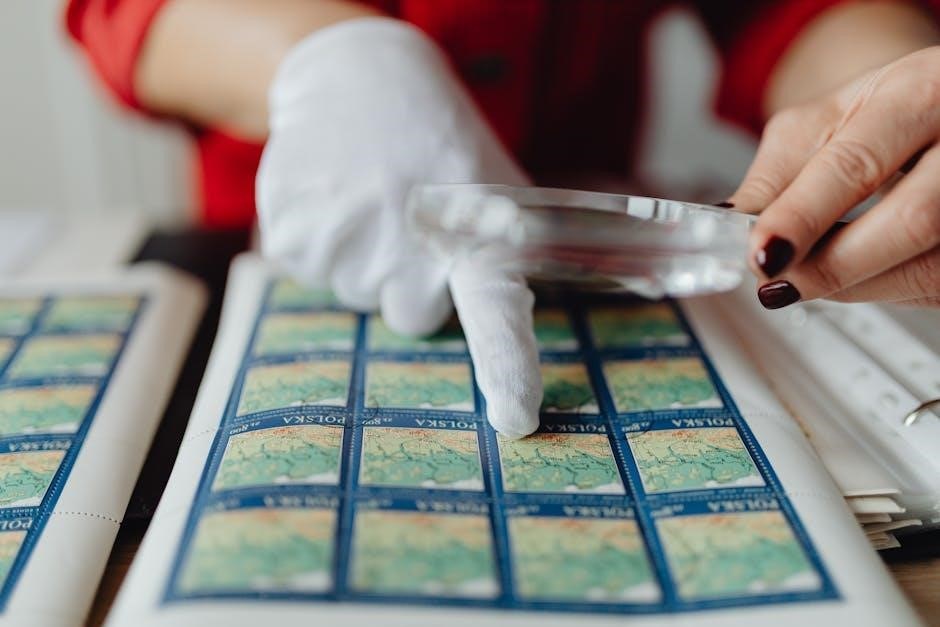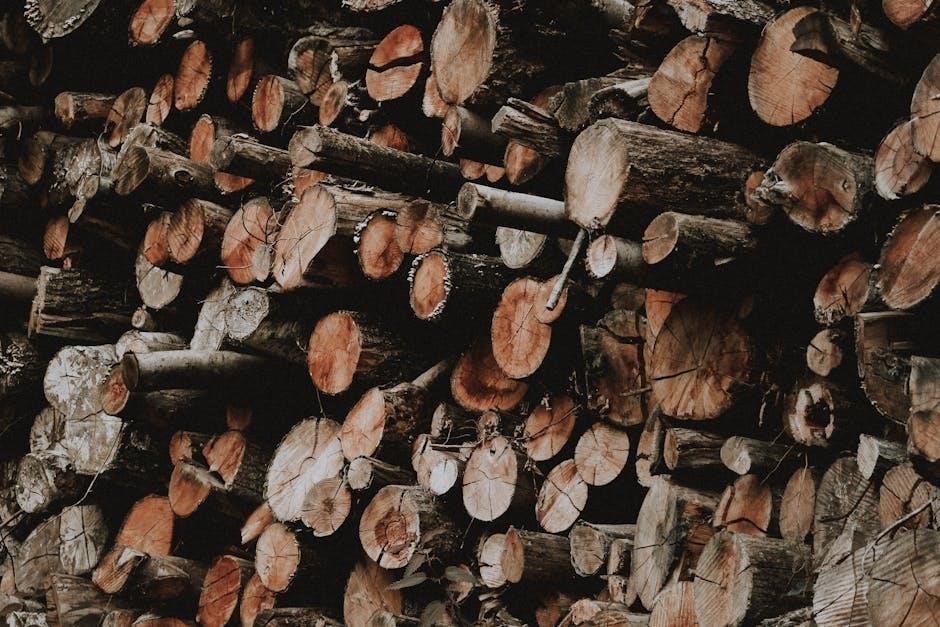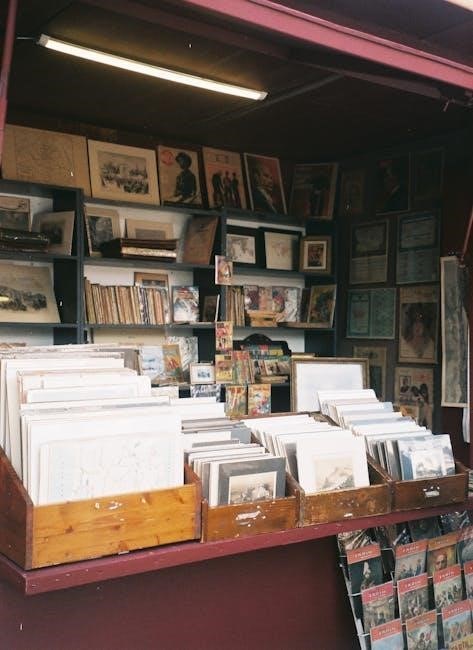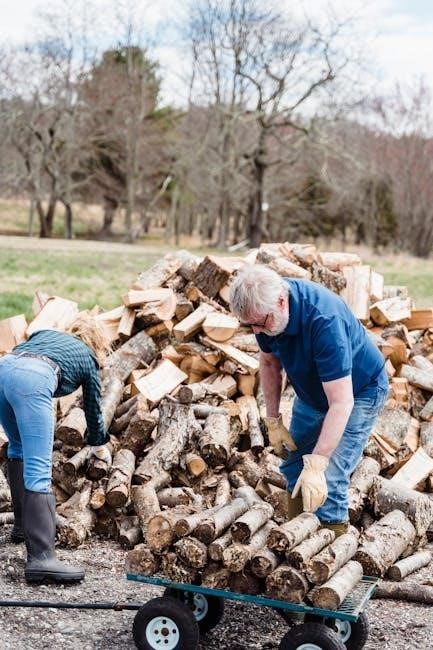Free firewood collection maps for Washington State in 2024 are essential for identifying legal and sustainable collection areas. These maps‚ often available in PDF format‚ guide users to approved locations while ensuring environmental protection and compliance with regulations.
1.1 Overview of Firewood Collection in Washington State
Firewood collection in Washington State is a popular activity for both recreational and personal use. The state offers designated areas for collecting firewood‚ ensuring sustainable practices and environmental protection; Maps and guides‚ such as the 2024 PDF maps‚ are available to help residents and visitors identify approved locations. These resources outline public lands‚ state trust lands‚ and private properties where firewood collection is permitted. The Washington Department of Natural Resources (DNR) and other agencies regulate the process to prevent over-harvesting and protect sensitive ecosystems. Collection periods‚ such as from April to September‚ are often specified to align with seasonal needs and forest management goals. Additionally‚ some areas require permits‚ while others allow free collection‚ depending on location and usage. Sustainable practices‚ like collecting downed wood and avoiding protected species‚ are strongly encouraged to maintain the balance of Washington’s forests.

Legal Considerations
Firewood collection in Washington State requires adherence to specific regulations. Permits are mandatory in certain areas‚ such as Disease Risk Areas (DRA)‚ to ensure sustainable harvesting and prevent illegal activities. Designated collection zones help protect ecosystems and wildlife habitats‚ ensuring responsible use of natural resources while maintaining environmental balance.

2.1 Permits Required for Firewood Collection
Firewood collection in Washington State often requires a permit to ensure sustainable practices and legal compliance. The Washington State Department of Natural Resources (DNR) issues permits for firewood cutting on public lands‚ while private landowners may require written permission. Permits are essential for harvesting firewood in designated areas‚ including state forests and national parks. They help regulate the amount of wood collected and prevent over-harvesting‚ which can harm ecosystems. Penalties for collecting firewood without a permit can include fines and confiscation of collected materials. Permits are typically available online or at local DNR offices‚ and they specify allowed tree species‚ collection limits‚ and valid periods. Always check with local authorities for up-to-date permit requirements before collecting firewood. This ensures responsible resource use and helps maintain Washington’s natural resources for future generations. Visit the DNR website for detailed information and to apply for a permit.
2.2 Prohibited Areas for Firewood Collection
Firewood collection is strictly prohibited in certain areas across Washington State to protect sensitive ecosystems and cultural sites. National parks‚ wildlife reserves‚ and areas designated as critical habitats for endangered species are off-limits to firewood collection. Additionally‚ state parks‚ urban green spaces‚ and areas affected by wildfires or natural disasters are typically restricted. Private property‚ including tribal lands‚ also requires explicit permission and is not open for public firewood collection without consent. The Washington Department of Natural Resources (DNR) and other agencies enforce these restrictions to preserve natural resources and ensure environmental sustainability. Violating these prohibitions can result in penalties‚ fines‚ and legal action. Always consult the 2024 firewood collection maps or contact local authorities to confirm permissible areas before collecting firewood. This ensures compliance with regulations and helps protect Washington’s diverse landscapes for future generations.
2.3 Penalties for Illegal Firewood Collection
Engaging in illegal firewood collection in Washington State can result in significant penalties; Violators may face fines ranging from $500 to $5‚000‚ depending on the severity of the offense. Repeat offenders or those collecting large quantities of firewood illegally may incur higher penalties. Additionally‚ illegal firewood may be confiscated‚ and individuals could be required to pay restitution for damages to public or private lands. In some cases‚ illegal firewood collection on protected or restricted areas may lead to criminal charges‚ including misdemeanors or felonies. These penalties are enforced by the Washington Department of Natural Resources (DNR) and other regulatory agencies to deter unauthorized activities and protect natural resources. It is crucial to adhere to legal guidelines and obtain necessary permits to avoid these consequences. Always consult the 2024 firewood collection maps or contact local authorities to ensure compliance with state regulations.

Where to Collect Firewood
Firewood collection in Washington State is permitted in designated areas on public and private lands. State forests‚ national parks‚ and certain wildlife areas offer specific zones for firewood gathering. Always obtain required permits and follow local regulations to ensure legal and sustainable practices. Use the 2024 PDF maps to identify approved locations and avoid restricted areas. Private lands require landowner permission. Adhere to environmental guidelines to protect ecosystems and wildlife habitats. Check for updates on accessible areas and seasonal restrictions before heading out. Proper planning ensures a smooth and lawful firewood collection experience.
3.1 Public Lands Open for Firewood Collection

Public lands in Washington State offer numerous opportunities for firewood collection‚ but it’s essential to know where it’s permitted. National forests like the Okanogan-Wenatchee and Mount Baker-Snoqualmie allow firewood gathering in designated areas. State forests‚ such as those managed by the Department of Natural Resources (DNR)‚ also provide access‚ though permits are often required. Wildlife areas and certain county lands may open for firewood collection seasonally. Always refer to the 2024 PDF maps for precise locations and restrictions. These maps highlight accessible zones‚ ensuring compliance with environmental and safety standards. Public lands are a great resource‚ but remember to follow local regulations and obtain necessary permits to avoid penalties. Respect protected zones and wildlife habitats to promote sustainable practices. Check for updates before heading out‚ as availability can change due to weather or environmental conditions.
3.2 Private Lands and Permission Requirements
Collecting firewood on private lands in Washington State requires explicit permission from the landowner. Unlike public lands‚ there are no generalized permits for private property firewood collection. Landowners may grant permission for personal use‚ often free of charge‚ but it’s crucial to obtain written consent to avoid legal issues. Some private landowners may offer firewood collection opportunities through local classifieds or community boards‚ especially after tree removal projects. Always respect property rights and ensure you have clear authorization before collecting firewood. Additionally‚ be mindful of environmental practices and avoid damaging the land or surrounding ecosystems. For more information on finding private lands with permission‚ refer to local resources or 2024 PDF maps that may highlight accessible private areas. Remember‚ collecting firewood without permission is illegal and can result in penalties. Always prioritize responsible and lawful practices when gathering firewood on private property.

Tools and Resources
Utilize 2024 PDF maps and GPS tools to identify firewood collection areas in Washington State. These resources provide detailed locations and regulations‚ ensuring legal and efficient firewood gathering.
4.1 PDF Maps for Firewood Collection Areas
The Washington State Department of Natural Resources (DNR) provides free‚ downloadable PDF maps for firewood collection in 2024. These maps outline designated areas where firewood gathering is permitted‚ ensuring users comply with local regulations. Available on the DNR website‚ the maps detail forest locations‚ accessible roads‚ and specific areas open to firewood collection. They also highlight protected zones and restricted sites to prevent illegal activities. Users can zoom in on the maps to identify precise collection spots and plan their trips efficiently. The maps are updated annually to reflect changes in land use‚ environmental conditions‚ and new regulations. By using these resources‚ collectors can ensure they follow sustainable practices and avoid penalties. The PDF format allows for easy printing or downloading to mobile devices‚ making it a practical tool for planning firewood collection trips in Washington State.
4.2 GPS Tools for Locating Collection Spots
GPS tools are invaluable for locating firewood collection spots in Washington State. The Washington Department of Natural Resources (DNR) offers free‚ downloadable GPS-compatible maps and coordinates for 2024. These tools help users pinpoint exact locations where firewood collection is permitted‚ ensuring compliance with regulations. Many GPS apps‚ such as Avenza Maps and Gaia GPS‚ support the DNR’s PDF maps‚ allowing users to navigate remote areas with precision. Additionally‚ some forestry websites provide geospatial data in KML or GPX formats‚ which can be imported into GPS devices or smartphones. These tools often include real-time updates‚ trail information‚ and boundary markers to avoid restricted areas. By using GPS technology‚ collectors can efficiently locate legal firewood collection spots while minimizing environmental impact. This resource is particularly useful for those exploring vast public lands in Washington State‚ ensuring a seamless and sustainable firewood gathering experience.

Environmental Impact
Sustainable firewood collection practices are vital to protect Washington’s ecosystems. Responsible harvesting prevents soil erosion‚ preserves biodiversity‚ and maintains forest health. Using 2024 maps ensures collectors avoid sensitive habitats‚ promoting eco-friendly practices.
5;1 Sustainable Firewood Collection Practices
Sustainable firewood collection practices are essential to minimize environmental impact in Washington State. Collectors should only harvest dead or downed trees to avoid harming living vegetation. Using 2024 PDF maps helps identify areas where collection is permitted‚ ensuring compliance with environmental regulations. It’s important to avoid over-harvesting‚ as this can deplete forest resources and disrupt ecosystems. Collectors should also refrain from damaging surrounding plants or soil‚ as this can lead to erosion and habitat loss. Additionally‚ proper disposal of debris and respect for forest regeneration areas are crucial. By adhering to these practices‚ collectors can help maintain healthy forests while meeting their firewood needs. Sustainable practices not only preserve biodiversity but also ensure that future generations can benefit from these resources. Always follow local guidelines and respect the land to promote environmental stewardship.

Safety Tips
Always wear protective gear‚ including gloves and eyewear‚ when collecting firewood. Use proper tools and ensure your vehicle is equipped for transport. Be aware of wildlife and steep slopes‚ and keep a first aid kit handy. Avoid overexertion and plan for changing weather conditions. Ensure someone knows your location and estimated return time. Follow all safety guidelines to prevent accidents and injuries while collecting firewood in Washington State.

6.1 Essential Safety Precautions
When collecting firewood‚ prioritize safety to avoid accidents. Always wear protective gear‚ including sturdy gloves‚ safety glasses‚ and a first aid kit. Ensure your tools are in good condition and suitable for the task. Be mindful of uneven terrain‚ loose branches‚ and wildlife habitats. Plan your route in advance and inform someone about your location and expected return time. Avoid collecting firewood in bad weather‚ as slippery surfaces and reduced visibility can increase risks. Keep a phone nearby for emergencies and stay hydrated. Never exceed your physical limits‚ and consider having a buddy for assistance. Properly secure your load during transport to prevent accidents on the road. By following these precautions‚ you can ensure a safe and successful firewood collection experience in Washington State.
2024 Updates
Washington State has introduced updated firewood collection maps for 2024‚ ensuring access to permitted areas while promoting sustainable practices. New regulations emphasize environmental protection and public safety.
7.1 New Regulations for 2024
In 2024‚ Washington State introduced updated regulations for firewood collection to ensure sustainability and environmental protection. Key changes include stricter limits on firewood collection in sensitive habitats and mandatory permits for certain areas. The Washington State Department of Natural Resources (DNR) now requires collectors to complete an online orientation before obtaining permits. Additionally‚ the maximum allowable firewood length has been reduced to minimize waste and prevent over-harvesting. New rules also prohibit collecting firewood in areas designated for wildlife conservation or reforestation. These changes aim to balance recreational needs with ecological preservation. Collectors are encouraged to download the latest PDF maps‚ which highlight restricted zones and newly accessible areas. Compliance with these regulations is essential to avoid penalties and support sustainable forestry practices statewide.
7.2 Newly Opened Collection Areas
In 2024‚ Washington State has designated several new areas for firewood collection to meet public demand while promoting sustainable forestry. These areas include portions of the Olympic Peninsula and select regions within the Okanogan-Wenatchee National Forest. The newly opened zones are identified on updated PDF maps‚ which are available for free download on the Washington State Department of Natural Resources (DNR) website; Each area has specific guidelines‚ such as limits on the amount of firewood that can be collected and restrictions on vehicle access. Collectors are required to follow posted signs and adhere to environmental guidelines to protect sensitive habitats. The DNR has also introduced a new interactive map tool that helps users locate these areas and plan their trips efficiently. These changes aim to provide more opportunities for firewood collection while ensuring the long-term health of Washington’s forests.
Collecting firewood in Washington State can be a rewarding and cost-effective way to gather fuel‚ especially with the availability of free 2024 PDF maps. These resources provide essential information to help individuals navigate the rules‚ locations‚ and best practices for firewood collection. By adhering to legal guidelines and practicing sustainability‚ collectors can enjoy the benefits of firewood while supporting the preservation of Washington’s forests. The newly updated maps and regulations for 2024 ensure that firewood collection remains accessible and environmentally responsible. Always remember to check the latest resources and follow safety precautions to make your firewood collection experience both successful and enjoyable. With proper planning and adherence to the rules‚ you can contribute to sustainable forestry practices while meeting your firewood needs.

Additional Resources
For those seeking more detailed information on free firewood collection maps in Washington State for 2024‚ several resources are available to guide you. The Washington State Department of Natural Resources (DNR) offers downloadable PDF maps that highlight designated collection areas. Additionally‚ the U.S. Forest Service provides regional maps and guidelines for firewood collection on federal lands. Websites like www.dnr.wa.gov and www.fs.usda.gov are excellent starting points for downloading these resources. Non-governmental organizations‚ such as local conservation groups‚ may also offer supplementary guides. Mobile apps like Avenza Maps can help you navigate collection areas using GPS. Always cross-reference your maps with the latest regulations to ensure compliance. These tools will help you make the most of your firewood collection efforts in Washington State.

